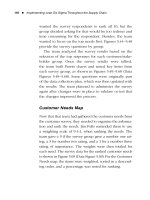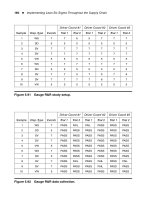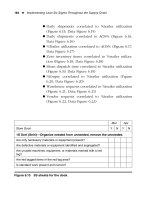Lean six sigma process improvement tools and techniques by donna summers a
Bạn đang xem bản rút gọn của tài liệu. Xem và tải ngay bản đầy đủ của tài liệu tại đây (75.14 KB, 26 trang )
Quality Function Deployment
Lean Six Sigma: Process Improvement Tools and Techniques
Donna C. Summers
© 2011 Pearson Higher Education,
Upper Saddle River, NJ 07458. • All Rights Reserved.
QFD
•
A Quality Function Deployment diagram is a matrix used to depict customer
requirements.
Lean Six Sigma: Process Improvement Tools and Techniques
Donna C. Summers
© 2011 Pearson Higher Education,
Upper Saddle River, NJ 07458. • All Rights Reserved.
QFD
•
A QFD is used to capture the voice of the customer and translate it into
technical information that an organization can use in order to create or
improve a product.
– Developed in Japan in the 1970s
– Dr. Akao
Lean Six Sigma: Process Improvement Tools and Techniques
Donna C. Summers
© 2011 Pearson Higher Education,
Upper Saddle River, NJ 07458. • All Rights Reserved.
QFD
•
It is often called a House of Quality because:
– Customer information
horizontally
– Technical information
is shown
is shown vertically
Customer
Information
Technical
Information
Lean Six Sigma: Process Improvement Tools and Techniques
Donna C. Summers
© 2011 Pearson Higher Education,
Upper Saddle River, NJ 07458. • All Rights Reserved.
QFD
•
QFD’s are planning and communication tools:
– Used for new product development
– Used to conform to customer demands
– Used any time you have customers and you need to identify
their expectations and turn that information into workable
technical specifications.
Lean Six Sigma: Process Improvement Tools and Techniques
Donna C. Summers
© 2011 Pearson Higher Education,
Upper Saddle River, NJ 07458. • All Rights Reserved.
QFD
•
QFDs are planning and communication tools:
– Used to help set strategic targets
– Used to help determine priority issues
– Used for analysis
– Used to estimate what the competition is doing
– Used to integrate complex information
Lean Six Sigma: Process Improvement Tools and Techniques
Donna C. Summers
© 2011 Pearson Higher Education,
Upper Saddle River, NJ 07458. • All Rights Reserved.
QFD
•
QFDs encourage:
–
–
–
–
–
–
–
Team building
Consensus
Creativity
Structure
Organization
Development of new ideas
Remove suggestiveness from the product development process
Lean Six Sigma: Process Improvement Tools and Techniques
Donna C. Summers
© 2011 Pearson Higher Education,
Upper Saddle River, NJ 07458. • All Rights Reserved.
Lean Six Sigma: Process Improvement Tools and Techniques
Donna C. Summers
© 2011 Pearson Higher Education,
Upper Saddle River, NJ 07458. • All Rights Reserved.
QFD
•
Building a QFD
–
–
–
–
–
–
–
–
–
–
–
–
Determine the Voice of the Customer
Have the customer rank the relative importance of his/her wants
Have the customer evaluate your company against competitors
Determine how the wants will be met
Determine the direction of improvement for the technical requirements
Determine the operational goals for the technical requirements
Determine the relationship between each of the customer wants and the
technical requirements
Determine the correlation between the technical requirements.
Compare the technical performance with that of competitors
Determine the column weights
Add regulatory and/or internal requirements
Analyze the QFD matrix
Lean Six Sigma: Process Improvement Tools and Techniques
Donna C. Summers
© 2011 Pearson Higher Education,
Upper Saddle River, NJ 07458. • All Rights Reserved.
QFD
•
Determine the Voice of the Customer
– Capture the Voice of the Customer
– Organize the Voice of the Customer
Lean Six Sigma: Process Improvement Tools and Techniques
Donna C. Summers
© 2011 Pearson Higher Education,
Upper Saddle River, NJ 07458. • All Rights Reserved.
QFD
•
Determine the Voice of the Customer: Four types of customers
– Those customers we already have and can’t lose
– Those customers we could lose easily
– Those customers we could gain with minor product changes
– Those customers we can’t get.
Lean Six Sigma: Process Improvement Tools and Techniques
Donna C. Summers
© 2011 Pearson Higher Education,
Upper Saddle River, NJ 07458. • All Rights Reserved.
QFD
• Determine the Voice of the Customer:
Categories of Customers
• Planner: Matches product with organizational need
• Funder: Pays for product, installation, maintenance, or
operation
• Auditor: Prevents misuse of product
• Installer: Integrates product into its environment
• Maintainer: Repairs the product
• Operator: works with product
• User 1: directly benefits from using product but may not be
final user
• User 2: directly benefits from using product
Lean Six Sigma: Process Improvement Tools and Techniques
Donna C. Summers
© 2011 Pearson Higher Education,
Upper Saddle River, NJ 07458. • All Rights Reserved.
QFD
•
Determine the Voice of the Customer: Kano Model
Satisfied Feeling
Exciting level
of Quality
Physically
fulfilled
condition
Basic level
of Quality
Lean Six Sigma: Process Improvement Tools and Techniques
Donna C. Summers
© 2011 Pearson Higher Education,
Upper Saddle River, NJ 07458. • All Rights Reserved.
QFD
•
Determine the Voice of the Customer: Capturing Customer information
– Determine people to talk to
• Determine the target market
• Determine whether or not to survey with or without
samples of the current product
• Determine whether or not to use an outside
organization to conduct the surveys
Lean Six Sigma: Process Improvement Tools and Techniques
Donna C. Summers
© 2011 Pearson Higher Education,
Upper Saddle River, NJ 07458. • All Rights Reserved.
QFD
•
Determine the Voice of the Customer: Capturing Customer information
– Determine people to talk to
• Determine how to contact the customers
–
–
–
–
–
Focus groups
Interviews (telephone, one-on-one, web/email)
Questionnaires
Product clinics
Observations
Lean Six Sigma: Process Improvement Tools and Techniques
Donna C. Summers
© 2011 Pearson Higher Education,
Upper Saddle River, NJ 07458. • All Rights Reserved.
QFD
•
Determine the Voice of the Customer
– Listen
– Observe
– Probe
• Ask for Reasons
– Clarity
– Understanding
– Issues
• Ask for Examples
– Show me, help me understand
Lean Six Sigma: Process Improvement Tools and Techniques
Donna C. Summers
© 2011 Pearson Higher Education,
Upper Saddle River, NJ 07458. • All Rights Reserved.
QFD
•
Determine the Voice of the Customer
– Be sure to ask: What questions didn’t we ask that we should
have?
– Be sure to capture the verbatims
• How did the customer say what they said?
Lean Six Sigma: Process Improvement Tools and Techniques
Donna C. Summers
© 2011 Pearson Higher Education,
Upper Saddle River, NJ 07458. • All Rights Reserved.
QFD
•
Step 1: Determine the Voice of the Customer
– What does the customer want?
– Organize the Voice of the Customer
• Using one ‘voice’ per post-it note, write down all
information
• Sort/organize the information (including verbatims)
that you have gathered
– Arrange the voices into groups
• Place on diagram (Figure 11.3)
Lean Six Sigma: Process Improvement Tools and Techniques
Donna C. Summers
© 2011 Pearson Higher Education,
Upper Saddle River, NJ 07458. • All Rights Reserved.
QFD
•
Step 2: Have the customer rank the relative importance of his/her wants
• Rank them all (Ten is highest rank. One is lowest.)
• Figure 11.4
•
Step 3: Have the customer evaluate your company against competitors
•
•
•
•
Chose two competitors
Have customer rank first, second, third
The organization with the most firsts is ranked first
Figure 11.5
Lean Six Sigma: Process Improvement Tools and Techniques
Donna C. Summers
© 2011 Pearson Higher Education,
Upper Saddle River, NJ 07458. • All Rights Reserved.
QFD
•
Step 4: Determine how the wants will be met
– How will the company provide for the wants?
• Translate the Voice of the Customer
• Turn verbatims into technical requirements
• Figure 11.6
Customer Verbatim -> Technical Requirement
Cup stays cool -> Temperature at hand
Won’t spill or tip: -> Tip force at top, fluid loss vertical/horizontal impact
Doesn’t leak -> Porosity
Lean Six Sigma: Process Improvement Tools and Techniques
Donna C. Summers
© 2011 Pearson Higher Education,
Upper Saddle River, NJ 07458. • All Rights Reserved.
QFD
•
Step 5: Determine the direction of improvement for the technical
requirements
• Figure 11.7
– A downward arrow means that improvement would
happen if we reduced the technical requirements value
– An upward arrow means that improvement would
happen if we increased the technical requirements value
– A circle means it should not be changed.
Lean Six Sigma: Process Improvement Tools and Techniques
Donna C. Summers
© 2011 Pearson Higher Education,
Upper Saddle River, NJ 07458. • All Rights Reserved.
QFD
• Step 6: Determine the operational goals for the
technical requirements
• Figure 11.8
Lean Six Sigma: Process Improvement Tools and Techniques
Donna C. Summers
© 2011 Pearson Higher Education,
Upper Saddle River, NJ 07458. • All Rights Reserved.
QFD
• Step 7: Determine the relationship between each
of the customer wants and the technical
requirements
• Figure 11.9
• How does action (change) on a technical requirement affect
customer satisfaction with the recorded want?
–
–
–
–
–
Strong positive correlation: Filled-in circle valued at 9
Positive correlation: open circle valued at 3
A weak correlation: triangle valued at 1
No correlation: empty box
Negative correlation: minus sign or x
Lean Six Sigma: Process Improvement Tools and Techniques
Donna C. Summers
© 2011 Pearson Higher Education,
Upper Saddle River, NJ 07458. • All Rights Reserved.
QFD
•
Step 8: Determine the correlation between the technical requirements.
• Figure 11.10
– Strong positive correlation: Open circle
– Negative correlation: minus sign or x
– No correlation: empty box
•
Step 9: Compare the technical performance with that of competitors
• Figure 11.11
Lean Six Sigma: Process Improvement Tools and Techniques
Donna C. Summers
© 2011 Pearson Higher Education,
Upper Saddle River, NJ 07458. • All Rights Reserved.
QFD
•
Step 10: Determine the column weights
• Multiply rankings by correlation values
• Figure 11.12
•
Step 11: Add regulatory and/or internal requirements
• Figure 11.12
Lean Six Sigma: Process Improvement Tools and Techniques
Donna C. Summers
© 2011 Pearson Higher Education,
Upper Saddle River, NJ 07458. • All Rights Reserved.









